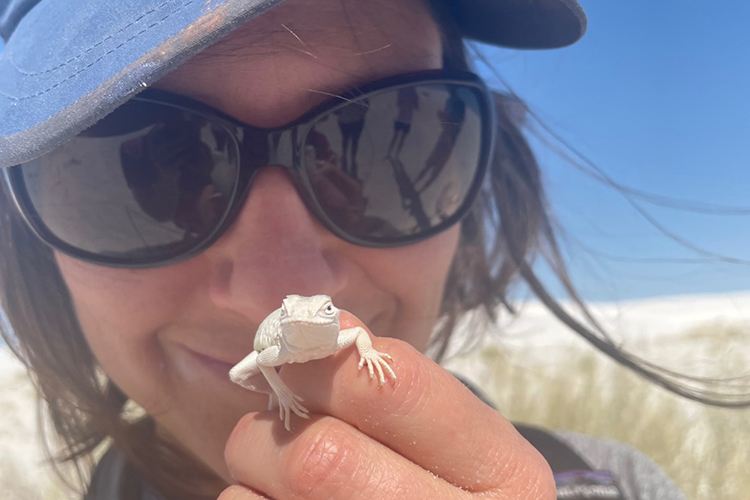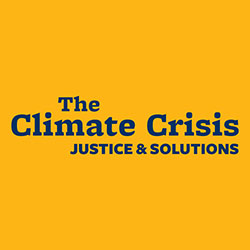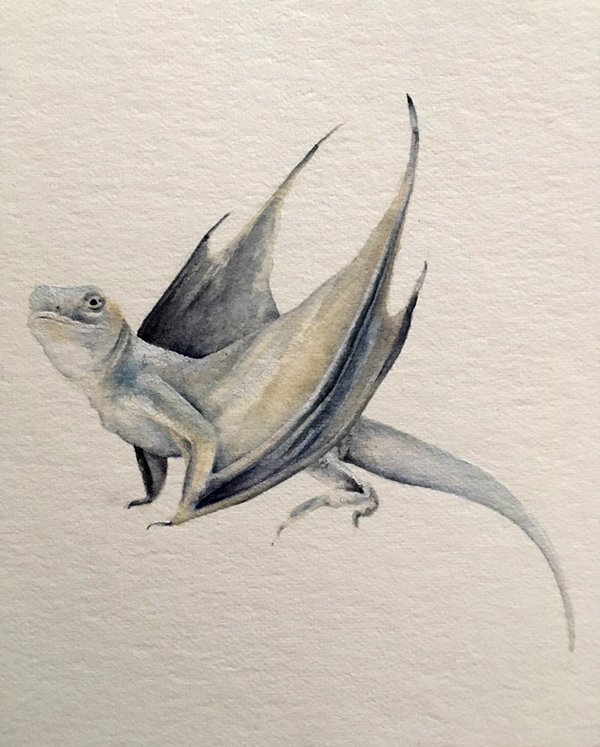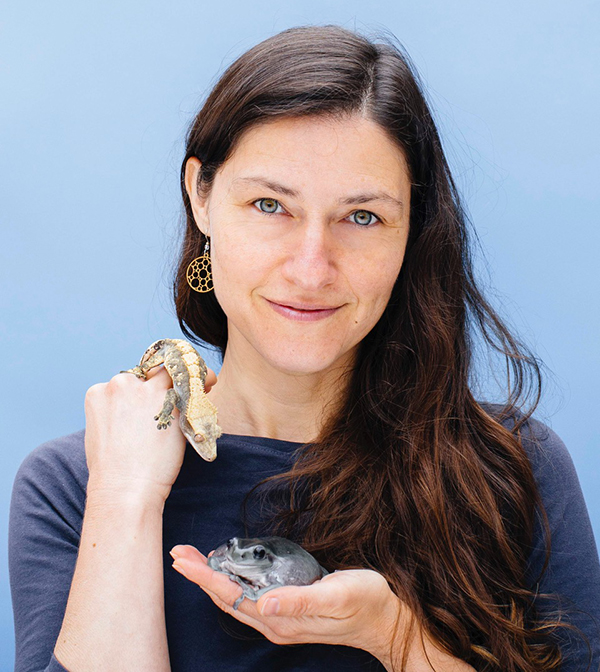Berkeley Voices: Biologist Confronts Deep Roots of Climate Despair
Follow Berkeley Voices, a Berkeley News podcast about the people and research that makes UC Berkeley the world-changing place that it is. Review us on Apple Podcasts.
See all Berkeley Voices episodes.
In this Berkeley Voices episode, Bree Rosenblum, a professor of global change biology at UC Berkeley, talks about why we need to stop blaming each other for the environmental crisis that we’re in, and instead confront its root causes and expand our ideas of what it means to be human on our planet. “I really think that if we’re not addressing culture at a really deep level, that we cannot address climate change,” said Rosenblum. “Do we want humanity to mean what it has meant in the past, or do we want to create a new meaning for our species and our purpose?”

Read a transcript of Berkeley Voices episode 97, ‘Biologist confronts deep roots of climate despair.’
[Music: “Tan Mountain” by Blue Dot Sessions]
Bree Rosenblum: I really think that if we’re not addressing culture at a really deep level, that we cannot address climate change.
Anne Brice: Bree Rosenblum was hired at UC Berkeley in 2012 to lead a research and teaching program in global change biology.
Bree Rosenblum: And it rapidly became kind of my favorite thing. It’s just such a compelling area of study and also one that requires a lot of thoughtfulness about how to engage students on a topic that could be so demoralizing and depressing, and how to do it in a way that’s honest, but also inspiring.
Anne Brice: Global change biology addresses how living systems are responding to the complex threats they face right now, like habitat destruction, the homogenization of biodiversity and climate change.
Bree Rosenblum: This generation of students has been bombarded by climate doomsday thinking from the time they were very young. In my experience, in the American culture — not to overreach into other cultural streams on our planet — but at least in mainstream American culture, I think this has had an enormous impact on the psyches of young people.
Anne Brice: This is Berkeley Voices. I’m Anne Brice.
This is the first episode of a two-part series about how to resist the feeling of doom that many of us experience when thinking about climate change.

In this episode, Rosenblum — a professor of global change biology in the Department of Environmental Science, Policy and Management — talks about why we need to stop blaming each other for the environmental crisis that we’re in, and instead confront its root causes and expand our ideas of what it means to be human on our planet.
[Music fades]
I’m joined by a colleague of mine, Kara Manke, a science writer for Berkeley News in the Office of Communications and Public Affairs. Kara is leading a series that explores how the campus community is creating innovative climate solutions and implementing them in ways that ensure a more equitable future for our planet. Hi, Kara. Welcome to Berkeley Voices.
Kara Manke: Hi, Anne. It’s nice to be here.
Anne Brice: So, Kara, you recently interviewed Rosenblum about her work in global change biology. Can you explain what Rosenblum studies, broadly?
Kara Manke: Yeah. Rosenblum studies a lot of different things about biodiversity on our planet. She’s interested in how we get new species and why we’re losing species at an alarming rate. And also, how the choices that humans make can affect both of those biological processes.
Anne Brice: You started out the conversation talking about her favorite animal. And so, I was wondering, could you talk about what animals she studies in her research and a little bit about her favorite animal?
Kara Manke: Sure. In her research, she studies reptiles and amphibians. And she said her favorite species is a Holbrookia maculata, commonly known as the lesser earless lizard. During the interview, she actually held up a drawing of the lizard that a student had made for her.
Bree Rosenblum: These are lizards that live in the southwest desert in the United States. And the reason why I love them is because, for me, they’re really an example of how quickly life on this planet can adapt to changing conditions.
So, the particular drawing that I showed you is of a white lizard, and they’ve evolved this white color very, very quickly, just in the very recent past, because their environment changed and they’ve colonized a whole suite of white sand dunes where normally they would be living in the dark desert.
And so, I think just being able to hold these little white lizards and these little brown lizards that were, you know, until a couple thousand years ago, probably the very same species and then underwent this really rapid divergence is compelling to me because I get to study all of the things that that lead critters to adapt to changing conditions.

That was really kind of my entry as a scientist into thinking about global change, was thinking about it in the past. Now, I think a lot about the future. But at the time, you know, as an evolutionary biologist, I was really focused on how did species get to where they are today, and how might they have changed in the past to meet changing environmental conditions?
And then obviously, in our generation, we find ourselves at a moment in history where the environment is changing so rapidly that those studies of the past are really most relevant when we can think and apply them towards the future.
Kara Manke: That’s really fascinating. I love that framing. Could you talk a little bit about how you’re finding that climate change and other environmental impacts are affecting some of the creatures that you study?
Bree Rosenblum: Yeah.
[Music: “Insatiable Toad” by Blue Dot Sessions]
So… I’ll probably broaden out a little bit because I study a lot of different things that I consider part of global change that aren’t climate change.
You know, I study not only how the climate is changing, but other ways that humans are changing not just the atmosphere, but conditions on the land and the sea and ways that we’re moving species around, ways that we’re moving diseases around. There’s a lot that we’re doing to the environment and with the environment that is beyond just changes in climate per se.
There are all of these different components of environmental change that are working in synergy. So, a lot of what I study is how those synergistic effects kind of add up to more than what they would if they were there on their own.
Anne Brice: Last year, Rosenblum published the textbook, Global Change Biology: The study of life on a rapidly changing planet. She says while she was writing the textbook, she relied on her students to help guide the process.
Bree Rosenblum: In those first years of teaching, my students were really involved in helping me think through, “What materials do they really need to learn this well?” And there wasn’t a textbook for the field. There are much more narrow books about climate change by itself, or marine ecosystems by themselves.
So, I really wanted to think about: Is there a way that I could present all of this material in a very student-centered way that felt more natural and like we were really just sitting down and looking at the world together, and we weren’t making people feel horribly guilty or horribly depressed or unabashedly optimistic. That didn’t have a particular stance, but kind of let students be on a journey.
One of the subtle shifts in the way I wrote that textbook was kind of challenging myself to be honest about what I think, but also not preassume that there’s a villain in every story, because I find that a lot of the material around, you know, climate change and global change has already preassumed humans as a villain. And not only is that depressing for students, but in my experience, it actually brings out the worst in us as humans.
[Music fades]
Anne Brice: Rosenblum says that because we live in such an externally oriented culture, it’s really easy to look at our own individual lives as separate from what’s happening on a global sphere. So, climate change is out there in the atmosphere. Or, habitat destruction is out there in the Amazon rainforest.
And by thinking that everything is out there, we’ve completely neglected our own internal landscape of what it means to be human and what culture we actually want to live in.
Bree Rosenblum: So, a lot of my work with students is really around addressing the way that culture lives in each one of us, because it’s way too easy to say everyone else is to blame. The factory farmers are to blame. The people cutting down the trees are to blame. It’s way too easy to put that blame out there and not address the ways in which the root causes of disconnect and alienation and lack and loneliness live inside of our own hearts.
Kara Manke: Hm mm. I’d love some specific examples, because I think we do live in this very, you know, the external culture is very strong. And so, I’m curious about how to sort of shift that, even on a small level?
Bree Rosenblum: One thing that we do is we do a lot of mapping of root causes. Like, imagine a tree, right? And the branches of the tree are all of the symptoms that we see on the planet right now. So, you could put climate change and species extinction — not all the symptoms of everything, but just in the global change arena.
I’ll have the students kind of take one issue. So, we’ll start with species extinction. They’ve been studying species extinction for the semester that we’re together, and they get in groups, and they start mapping what are the causes of extinction.

They start with the obvious things, like we’re cutting down habitat. And then, I push them to map those down to their causes, so every single time, they’re like, “Oh, I know. Habitat destruction is leading to species extinction.” It’s like, “Yeah, but what’s causing habitat destruction?”
And so, they kind of keep going, right? Well, what’s causing habitat destruction? You can see this could go in lots of different directions, depending on the student’s worldview and what their experience has been. They could go from habitat destruction to, you know, resource use or to human population size or to capitalism, right? They can go lots of places.
But I keep pushing them down until they get someplace that they can’t identify a cause underneath that. And usually they bottom out at very fundamental human things, like greed or loneliness or isolation.
[Music: “Gambrel” by Blue Dot Sessions]
Most of the students are really shocked because we’re so used to just going to kind of a material explanation of, like, “Well, there are too many people on the planet, we need so much stuff. We’re extracting and exploiting resources. And so, then things die.” And it’s like, “Yeah, but…” Right?
And so, once they’ve gone and mapped down to the root causes, the second half of that exploration is to come back up and look at how those same root causes affect other things they care about in their lives.
The last part of that exercise is that then I ask the students to think about how they could address the root causes in their lives, instead of addressing the symptoms.
It’s a very empowered stance to say, “OK, alienation is leading to species extinctions.” How do I address species extinctions? That is so far beyond any 20-year-old to feel like they can make a meaningful contribution.
But if I ask them, “How can I address alienation in my life?” Then all of a sudden, they’ve got this huge, 360-degree vista of really exciting things that really recruit their own talents and skills and dreams and aspirations.
And then, we spend a lot of time with the, like, “Well, is it OK? Is it OK if what I really want to do is propagate orchids and give them away to people on the street? Is that really combating climate change?” Well, it’s like, is it combating alienation? Yes. Is it something you’re passionate about? Yes. So, why wouldn’t that have intrinsic value?
[Music fades]
Kara Manke: You mentioned this a little bit when working on the exercise with the students on root causes about how we get to almost, like, human values … I’m not sure how to describe them. But could you talk about some of those that keep coming up and how you think they’re contributing?
Bree Rosenblum: Yeah. So, in my experience — and a lot of environmental scholars have written about this, it’s not novel scholarship, it’s just the way I present it to the students — is that there are basically two worldviews that are competing in our society right now. And again, our Western society that has grown these particular roots.
The first is a many-thousands-year-old view that humans are superior to other species on the planet. That’s kind of like, humans are the best thing in the world. And that leads to a very particular environmental worldview where resources are materialistic things that are fine for us to extract and use as we want because we’re the best, and the whole planet is here for us. That’s one of the environmental worldviews that, even if people don’t admit to, it’s usually floating in the mix someplace in our psyches.
And this is how it’s so easy for us to kind of divorce ourselves from the degree of exploitation that’s required to maintain our lifestyles, right? It’s like, “Oh, well, we’re so great. So like, yeah, we’re destroying the rainforest, but like, I need my cellphone.” There’s a superiority mentality that’s embedded in kind of the capitalist machine.
The second competing environmental worldview is that humans suck, and we screwed up so badly that we should just be wiped off from the face of the earth.
I used to do this exercise with my students before every class where I’d have them just do a quick doodle on a theme. It was eliciting just their feelings about something without trying to make it really science-y.
When I used to ask, just take five minutes, and just doodle a picture of what you think the single biggest solution would be to our current environmental crisis, the most common picture I would get would be a stick figure person with an enormous eraser. So, something on that theme. So, the theme that if we could erase humans, everything would be fine.
So, these two worldviews are competing, not just in different people and leading to culture wars, but they’re actually competing inside us. Most people, if you actually get them to be really honest, hold both of these views simultaneously — that we’re totally awesome, and we totally suck. So, we are the problem, and we’re the solution. And it creates a lot of inner friction because people are spending a lot of time trying to figure out, like, “Am I awesome, or do I suck? Not only me individually, but my entire species.”
Obviously, I don’t think either of those environmental worldviews are particularly inspiring or fruitful, but I think that is where we’re at, in terms of how we need to kind of talk about the reality of the situation.
Kara Manke: Right, right. Do you think these are also contributing to the, kind of, feelings of helplessness and despair that people feel around these issues?
Bree Rosenblum: Yeah, of course, because not only are they contributing to an inner feeling of despair and hopelessness, but their effect on the world is devastating. You look at the evidence, and you’re like, “Oh, well, if humans are awesome, but that awesomeness leads to resource extraction, human exploitation and all of these other issues on our planet — wow, that’s not such a great worldview to live in.”
And then, on the converse, if we suck, and the best solution is just to destroy ourselves as quickly as possible and let the earth kind of rebuild after us, that’s incredibly depressing. So, I guess what I’m trying to say is that both of these worldviews lead to a relationship with ourselves, each other and the planet that’s fundamentally depressing.
[Music: “Littl Jon” by Blue Dot Sessions]
I really think that if we’re not addressing culture at a really deep level, that we cannot address climate change. We can have technology be part of the solution. We can have activism be part of the solution. We can have regulation be part of the solution. But none of those things win on their own without addressing the cultural norms that got us to the place where humans… even if it wasn’t consciously thought it was fine to destroy other life forms, that humans subconsciously thought it was fine to treat other living things like this.
So, that, to me, is the biggest hope for this generation, is that I think young people are so tired of the cultural norms that kind of led to the environmental crisis that we’re in, that I think there’s actually an appetite for addressing the culture, in addition to doing the other, more external-facing work.
If I dim down all of the noise, like, all of the doomsday way we present things, if I dim down all the external noise and I listen to what feels true to me, it feels like a phenomenal time to be a human on this planet. We are in such an amazing individual and collective squeeze point.
Do we want humanity to mean what it has meant in the past, or do we want to create a new meaning for our species and our purpose?
Anne Brice: This is Berkeley Voices. I’m Anne Brice. Special thanks to Kara Manke, who coproduced and cohosted this episode.
This was part one of a two-part series about how building a sense of connection with our planet and all of its inhabitants is essential in reframing our time on Earth and our role in our changing climate and environment.
Next week, we’ll talk with Hope Gale-Hendry, a fourth-year student in ecosystem management and forestry, who was inspired to study the American pika after taking Rosenblum’s class.
Hope Gale-Hendry: The American pika is considered the canary in the coal mine for climate change. They are extremely temperature sensitive and very likely going to go extinct in the next century.
Outro: You can follow Berkeley Voices on Apple Podcasts, Spotify or wherever you listen. If you like what we do, follow us and leave us a rating and review. You can find all of our podcast episodes with transcripts and photos on Berkeley News at news.berkeley.edu/podcasts.
